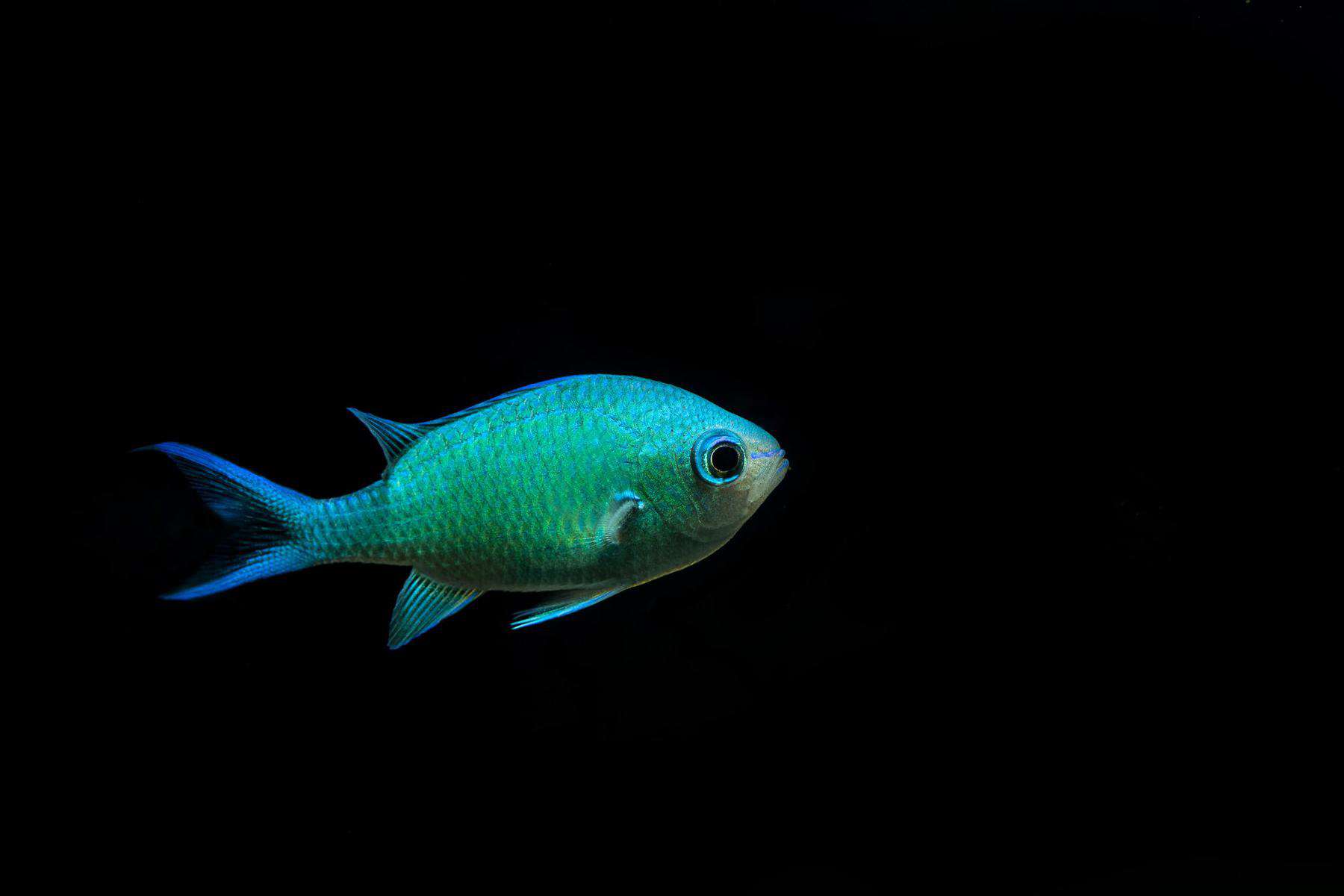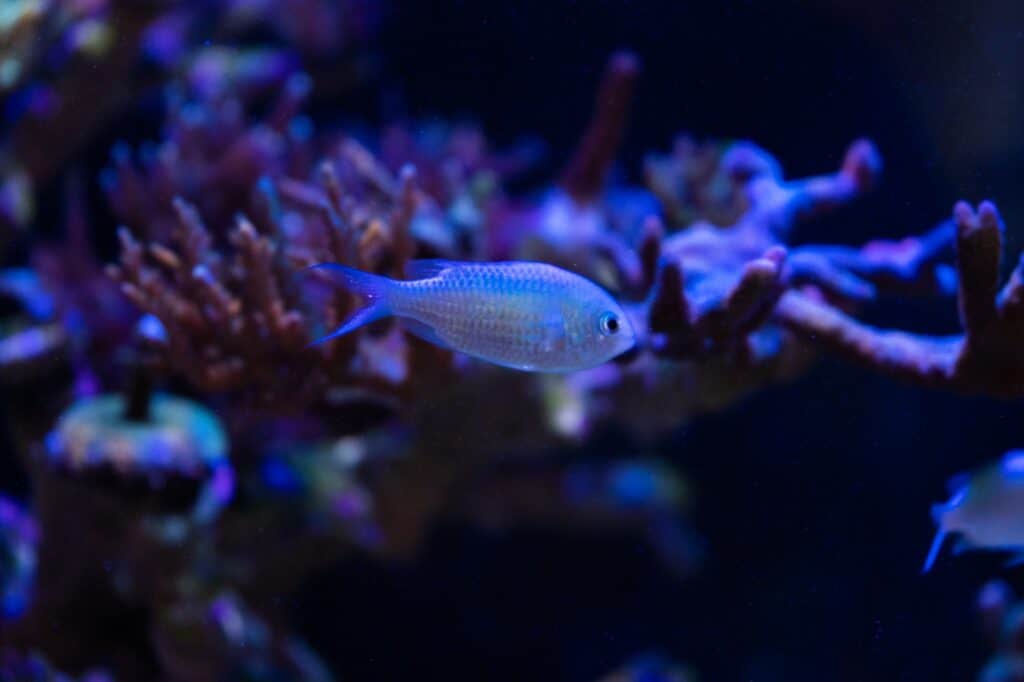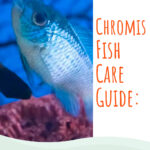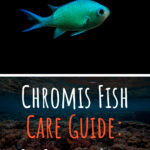If you’re just starting to get into the saltwater side of the hobby, then you’ve most likely heard of or seen a chromis fish in your local pet store. These small and colorful fish are an attractive choice for many beginners as they are usually seen peacefully schooling around the tank and are relatively inexpensive.
However, many species of Chromis are actually damselfish, which are largely known to be aggressive and a bad fit for most aquariums. This article will focus mainly on blue-green chromis and blue reef chromis.
Keep reading to find out everything you need to know about different species of chromis and if these saltwater fish are right for your aquarium!

Name
Chromis is a genus of saltwater fish that belongs to the Pomacentridae family. Members of this family are often known as the damselfish and the clownfish, with damselfish making up a large portion of Chromis.
There are over 100 different species of fish within Chromis, with many found commercially in the aquarium trade.
Natural habitat
Because there are so many different species of chromis, this article will mainly focus on blue-green chromis (Chromis viridis) and blue reef chromis (Chromis cyaneus).
Blue-green chromis (Chromis viridis). Many of the colorful fish that we fill our aquariums with originate from the Indo-Pacific region of the world around the rich waters of Indonesia and Australia. Mature blue-green chromis love to school above their natural habitat of large shallow reefs, swimming in and out of coral, like Acropora. Juvenile blue-green chromis stay in the rockwork until they are big enough to join the school above.

Blue reef chromis (Chromis cyaneus). Blue reef chromis come from the eastern hemisphere and range throughout the Gulf of Mexico and the Caribbean Sea. They can regularly be spotted while scuba-diving off the coasts of Bermuda and Florida. Blue reef chromis tend to shoal around deeper reef structures, forming territories that they retreat to when threatened.
Identification
It is important to understand that these two species of saltwater fish come from two totally different regions of the world, even though they come from the same genus. Luckily, they are pretty easy to physically tell apart from each. other.
Blue-green chromis (Chromis viridis). These chromis are named after their spectacular aqua-green coloration; in a school, they add a color that not many other saltwater fish can. Blue-green chromis reach a maximum size of about 4 inches (10.2 cm) when fully grown.
They have simple body features and a forked tail. With exceptional care, blue-green chromis can live up to 15 years.
Blue reef chromis (Chromis cyaneus). Besides having a similar body shape, the blue reef chromis looks completely different from the blue-green chromis. The blue reef chromis is a striking dark blue and has black margins along the back dorsal, dorsal fin, anal fin, and caudal fin.
These fish grow a little larger, reaching maximum lengths of 5-6 inches (12.7-15.2 cm). These fish also tend to be considerably more expensive than the blue-green chromis.
There are many other species of Chromis that you’re likely to come across in the aquarium hobby, including agile chromis (Chromis agilis), black-bar chromis (Chromis retrofasciata), and black and white/bicolor chromis (Chromis margaritifer), though these two listed species tend to be the most popular.
How big do chromis fish get?
In general, chromis stay at a small size. It isn’t likely that you will ever see one of these fish grow to be more than 6 inches (15.2 cm) big, though they can surely grow a gut depending on how much they eat!
Chromis tank requirements
While largely regarded as a beginner fish with low tank requirements, there’s some debate about whether some chromis should be kept in the aquarium at all. On many aquarium sites, 30 gallons (113.6 L) is the minimum tank size recommended. However, due to schooling and territory needs, we recommend as big a tank size as possible.
For the most part, hobbyists like to keep chromis in schools, though some have had success keeping pairs in smaller tank setups. It is recommended to keep at least 7 or more together, keeping in mind that you will probably lose some within the first couple of months for reasons we will discuss later; blue-green chromis tend to do better in larger groups while blue reef chromis can be kept in smaller numbers due to their looser shoaling behavior.
If planning on keeping blue-green chromis, it’s best to have a lot of open water for swimming. These fish like to stay above and in front of the rockwork and you might even find them swimming against the current of powerheads and filters.
If planning on keeping blue reef chromis, then it’s best to have intricate rockwork where the fish can form individual territories. These fish don’t tend to actively school as much as blue-green chromis do and usually end up swimming sporadically around the tank.
Both species of chromis are considered to be reef safe, meaning they will not try to pick at any coral that might be in the tank. In fact, the contrasting colors of some coral species will make your chromis pop even more!
Are chromis fish hardy?
In general, chromis are hardy fish; almost all damselfish are recommended as beginner fish as they can withstand changing parameters and imperfect conditions better than most other saltwater fish. However, just because they are some of the best does not mean that they are as hardy as some other freshwater fish. Remember that saltwater aquarium systems tend to be slightly more delicate and susceptible to fluctuations than freshwater ones, especially in the first year of their lives.
It is also important to note that many hobbyists have struggled with finding healthy chromis over the past few years, especially blue-green chromis. These fish tend to be difficult to ship and end up losing their color and some weight along the way. Many blue-green chromis are also carriers of a parasite by the name of Uronema marinum.
Chromis tank mates

Keep in mind that even though these fish are relatively peaceful towards other fish, they are still part of the damselfish family and have the ability to stress other fish out.
Still, chromis generally do best with other peaceful fish, like clownfish, blennies, gobies, and tangs. However, just because they’re related to damselfish does not mean that they make the best tank mates for damsels; some hobbyists have had luck with this pairing, but both blue-green chromis and blue reef chromis can be territorial and temperamental. If you’re not able to keep significantly large groups of chromis, then it is not recommended to keep them with damsels.
Likewise, any predatory fish or invertebrate that can fit a blue-green chromis or blue reef chromis into its mouth will probably end up doing so one day!
Chromis behavior
Chromis tend to be labeled as peaceful marine fish, especially blue-green chromis. While they definitely look peaceful while swimming around the top of the tank together, they’re actually pretty notorious for managing to pick each other off until only one or two remains.
While schooling fish, chromis work on a pecking order where the weakest and/or sickest of the group gets harassed and even killed. Many times, chromis disappear overnight when the fish resort to their sleeping areas in the tank. If a fellow chromis comes too close or takes this territory, they might also be chased away or killed.
And while schooling fish, it is not always guaranteed that chromis will actually school together in your tank. Some hobbyists have had luck introducing more chromis into the tank in order to lessen aggression and to encourage schooling behaviors. Others have found that their chromis only school if there are more aggressive and threatening species in the tank.
If you’re lucky enough to have a school of chromis in your tank, be prepared to lose one or two along the way.
Are chromis fish aggressive?
Both blue-green chromis and blue reef chromis are usually labeled as the perfect marine starter fish due to their hardiness and peaceful demeanor. However, due to their hostile nature towards each other, these fish tend to be more on the aggressive side than completely peaceful.
Chromis diet
Chromis will largely accept most aquarium foods. They should be given a high-quality mixed diet of live, frozen, and freeze-dried foods in order to preserve their beautiful colorings. They should be offered a variety of fish flakes and pellets along with brine shrimp, bloodworms, mysis shrimp, and copepods.
Breeding chromis fish
Intentionally breeding chromis in the aquarium is difficult and it’s actually much more likely to happen by mistake. However, actually raising the fry tends to be all that more difficult; the problem is that fry are incredibly small when hatched, making transferring all of them to a more controllable tank nearly impossible. This means that the tank will need to be set up with rearing fry in mind, with no predators, a gentle water current, and a compatible aquarium filter.
Chromis fry diet is also very demanding, and they need to have a constant supply of small live foods, like zooplankton and brine shrimp nauplii; these foods need to be conditioned beforehand with high-quality supplements, meaning that the hobbyist will most likely need to farm these foods themselves. Most hobbyists fail to keep their chromis fry alive past a couple of weeks due to how much they need to eat and the specificity of the food required.
If you are wanting to try breeding your blue-green chromis or blue reef chromis, then it is best to set up the tank like their wild habitats in the Indo-Pacific reefs or Caribbean waters and keep water parameters ideal.
How do chromis breed?
In the wild, chromis form breeding pairings and build a nest together. While the breeding habit of these two species is similar, they both have distinct methods for successful spawning.
Blue-green chromis (Chromis viridis). Blue-green chromis mainly breed on the substrate. Males change color to a more muted yellow and create a nest that is usually shared by one or more females; these females are attracted by a ‘dance’ performed by the male.
Eggs are then laid in and attached to this nest. The males guard this nest and use their caudal fins to help water move over the eggs for ventilation. These eggs hatch within 2-3 days and the males eat any that are leftover.
Blue reef chromis (Chromis cyaneus). Blue reef chromis breed in almost the exact same way in the wild as the blue-green chromis, though they tend to be less picky about where they lay their eggs and might keep to the crevices of rockwork if conditions are right. One male is responsible for a nest and protects the eggs until they spawn.
The male blue reef chromis is less likely to change noticeably in color during these breeding periods.
Conclusion
Blue-green chromis and blue reef chromis are some of the most colorful saltwater species in the hobby, and some of the only schooling marine fish available. They are usually referred to as peaceful fish, but their pecking order within their schools becomes highly aggressive and hobbyists usually end up losing several fish over the course of a few months.
Because they do better in large schools, it is best to go much bigger than the recommended minimum tank size of 30 gallons to provide them with the most swimming space as possible and to deter aggression levels. Otherwise, they are pretty hardy fish and can withstand moderately imperfect water conditions.
If you have any questions about blue-green chromis, blue reef chromis, or any other species of chromis, don’t hesitate to leave a comment below!













if the blue-green chromis knock each other off until there’s only two left, then, why not start off with only two? I
Hi Susie!
I’ve personally tried keeping chromis in small groups because it was largely believed that they were schooling fish for a while. Every single time, I was left with either one or no fish. They’re honestly very difficult to keep and for one reason or another, they always end up dying.
If you’re lucky, you’ll have two that make it, but it’s better to not risk it and only get one from the start.